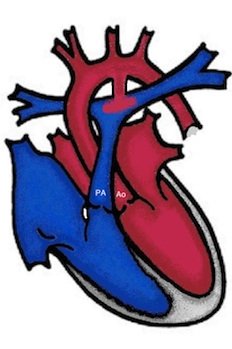Ductus arteriosus (PDA)
The ductus arteriosus is a small vessel that connects the main body artery (aorta = AO) with the pulmonary artery (PA) in the fetus (unborn baby). The ductus arteriosus normally closes after birth. According to one of its describers, the ductus arteriosus is also called the ductus botalli.
It is referred to as an open (persistent) ductus botalli - PDA - if it remains open after birth and blood flows through it from the aorta into the pulmonary artery. This is particularly the case with premature babies.
What are the effects of a persistent patent ductus arteriosus?
A small patent ductus botalli is often an incidental finding in a symptom-free child. With a large ductus arteriosus, a lot of blood flows from the aorta into the pulmonary artery, while the lungs are supplied with more blood, the body is less well supplied with blood despite increased heart work. Affected babies sweat when drinking, do not gain weight well and often breathe heavily. In some congenital heart defects, an open ductus arteriosus is life-saving because it allows blood to be mixed between the systemic and pulmonary circulation. In these children, the ductus arteriosus is kept open after birth by an infusion of the drug prostaglandin.
How is the patent ductus botalli treated?
Kleinere PDA’s können sich häufig im ersten Lebensjahr noch spontan verschließen. Ein großer Ductus mit hämodynamischer Wirksamkeit wird hingegen rasch verschlossen.
Smaller PDAs can often still close spontaneously in the first year of life. A large ductus with hemodynamic effectiveness, on the other hand, closes quickly.
Medication:
If the ductus botalli remains open, e.g. in a premature baby, medication can be administered to promote closure. If these drugs are unsuccessful, surgery is necessary.
Catheter intervention:
After the neonatal period, the operation is rarely performed and the catheter technique is used instead. A coil or a small umbrella (occulder) is inserted into the duct and closes it. Numerous implants are now available in various sizes and shapes, even for small babies. Access is via the groin. As with the ASD, the implant remains in the body and does not have to be removed later.
Operation:
The open ductus arteriosus botalli is surgically ligated (cut off) or closed with a clip.
